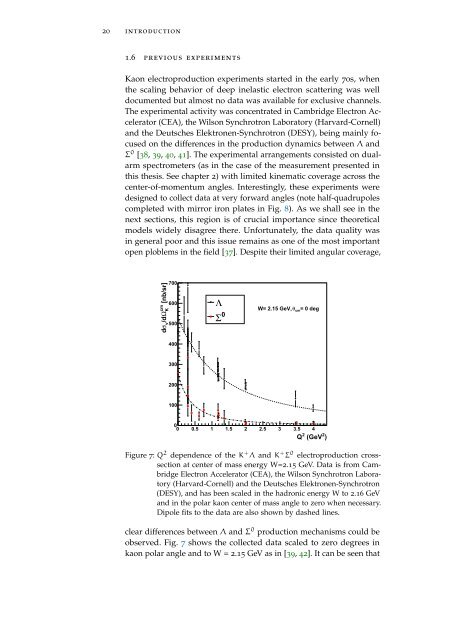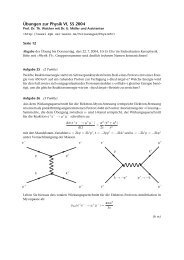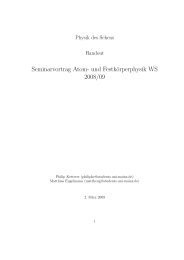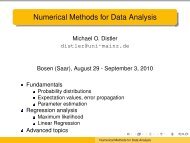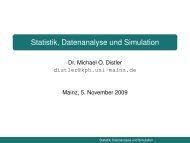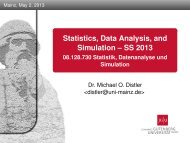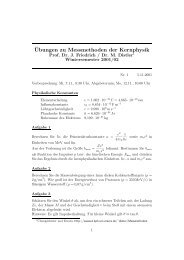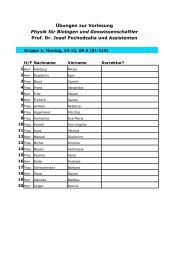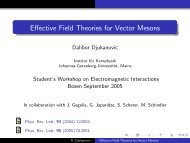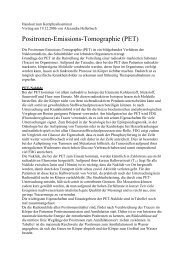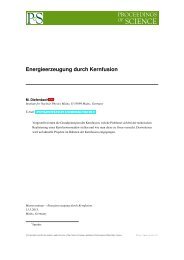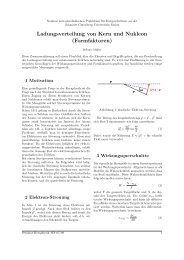A Classic Thesis Style - Johannes Gutenberg-Universität Mainz
A Classic Thesis Style - Johannes Gutenberg-Universität Mainz
A Classic Thesis Style - Johannes Gutenberg-Universität Mainz
Create successful ePaper yourself
Turn your PDF publications into a flip-book with our unique Google optimized e-Paper software.
20 introduction<br />
1.6 previous experiments<br />
Kaon electroproduction experiments started in the early 70s, when<br />
the scaling behavior of deep inelastic electron scattering was well<br />
documented but almost no data was available for exclusive channels.<br />
The experimental activity was concentrated in Cambridge Electron Accelerator<br />
(CEA), the Wilson Synchrotron Laboratory (Harvard-Cornell)<br />
and the Deutsches Elektronen-Synchrotron (DESY), being mainly focused<br />
on the differences in the production dynamics between Λ and<br />
Σ 0 [38, 39, 40, 41]. The experimental arrangements consisted on dualarm<br />
spectrometers (as in the case of the measurement presented in<br />
this thesis. See chapter 2) with limited kinematic coverage across the<br />
center-of-momentum angles. Interestingly, these experiments were<br />
designed to collect data at very forward angles (note half-quadrupoles<br />
completed with mirror iron plates in Fig. 8). As we shall see in the<br />
next sections, this region is of crucial importance since theoretical<br />
models widely disagree there. Unfortunately, the data quality was<br />
in general poor and this issue remains as one of the most important<br />
open ploblems in the field [37]. Despite their limited angular coverage,<br />
[nb/sr]<br />
cm<br />
K<br />
/dΩ<br />
v<br />
dσ<br />
700<br />
600<br />
500<br />
400<br />
300<br />
200<br />
100<br />
Λ<br />
0<br />
Σ<br />
W= 2.15 GeV, θcm=<br />
0 deg<br />
0<br />
0 0.5 1 1.5 2 2.5 3 3.5<br />
2<br />
Q<br />
4<br />
(GeV<br />
Figure 7: Q 2 dependence of the K + Λ and K + Σ 0 electroproduction crosssection<br />
at center of mass energy W=2.15 GeV. Data is from Cambridge<br />
Electron Accelerator (CEA), the Wilson Synchrotron Laboratory<br />
(Harvard-Cornell) and the Deutsches Elektronen-Synchrotron<br />
(DESY), and has been scaled in the hadronic energy W to 2.16 GeV<br />
and in the polar kaon center of mass angle to zero when necessary.<br />
Dipole fits to the data are also shown by dashed lines.<br />
clear differences between Λ and Σ 0 production mechanisms could be<br />
observed. Fig. 7 shows the collected data scaled to zero degrees in<br />
kaon polar angle and to W = 2.15 GeV as in [39, 42]. It can be seen that<br />
2<br />
)


